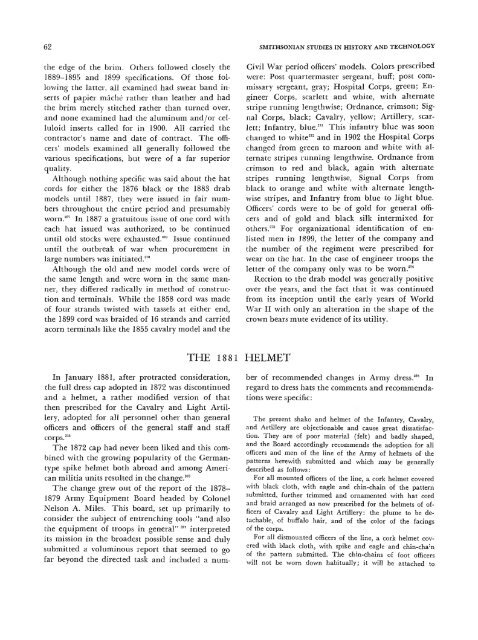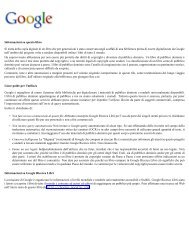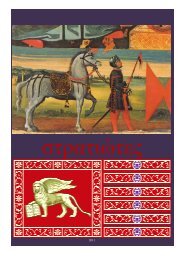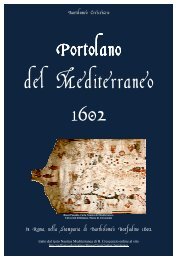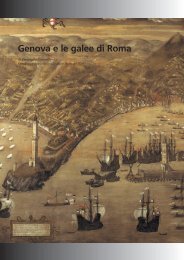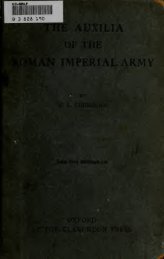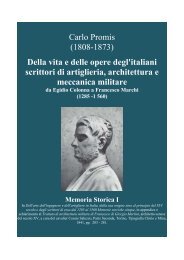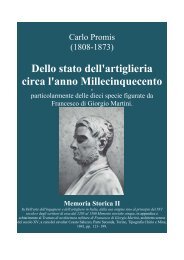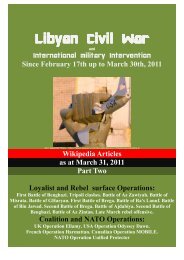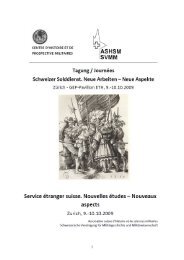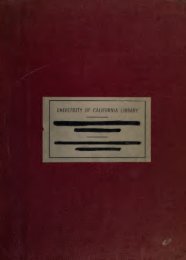62 SMITHSONIAN STUDIES IN HISTORY AND TECHNOLOGYthe edge of the brim. Others followed closely the1889-1895 and 1899 specifications. Of those followingthe latter, all examined had sweat band insertsof papier mache rather than leather and hadthe brim merely stitched rather than turned over,and none examined had the aluminum and/or celluloidinserts called for in 1900. All carried thecontractor's name and date of contract. The officers'models examined all generally followed thevarious specifications, but were of a far superiorquality.Although nothing specific was said about the hatcords for either the 1876 black or the 1883 drabmodels until 1887, they were issued in fair numbersthroughout the entire period and presumablyworn.'"' In 1887 a gratuitous issue of one cord witheach hat issued was authorized, to be continueduntil old stocks were exhausted.""" Issue continueduntil the outbreak of war when procurement inlarge numbers was initiated."'"Although the old and new model cords were ofthe same length and were worn in the same manner,they differed radically in method of constructionand terminals. While the 1858 cord was madeof four strands twisted with tassels at either end,the 1899 cord was braided of 16 strands and carriedacorn terminals like the <strong>1855</strong> cavalry model and theCivil War period officers' models. Colors prescribedwere: Post quartermaster sergeant, buff; post commissarysergeant, gray; Hospital Corps, green; EngineerCorps, Scarlett and white, with alternatestripe running lengthwise; Ordnance, crimson; SignalCorps, black; Cavalry, yellow; Artillery, Scarlett;Infantry, blue." This infantry blue was soonchanged to white"" and in <strong>1902</strong> the Hospital Corpschanged from green to maroon and white with alternatestripes running lengthwise. Ordnance fromcrimson to red and black, again with alternatestripes running lengthwise, Signal Corps fromblack to orange and white with alternate lengthwisestripes, and Infantry from blue to light blue.Officers' cords were to be of gold for general officersand of gold and black silk intermixed forothers."'" For organizational identification of enlistedmen in 1899, the letter of the company andthe number of the regiment were prescribed forwear on the hat. In the case of engineer troops theletter of the company only was to be worn."^*Rection to the drab model was generally positiveover the years, and the fact that it was continuedfrom its inception until the early years of WorldWar II with only an alteration in the shape of thecrown bears mute evidence of its utility.THE 1881 HELMETIn January 1881, after protracted consideration,the full dress cap adopted in 1872 was discontinuedand a helmet, a rather modified version of thatthen prescribed for the Cavalry and Light Artillery,adopted for all personnel other than generalofficers and officers of the general staff and staffcorps."""The 1872 cap had never been liked and this combinedwith the growing popularity of the Germantypespike helmet both abroad and among Americanmilitia units resulted in the change."'"The change grew out of the report of the 1878-1879 <strong>Army</strong> Equipment Board headed by ColonelNelson A. Miles. This board, set up primarily toconsider the subject of entrenching tools "and alsothe equipment of troops in general" "" interpretedits mission in the broadest possible sense and dulysubmitted a voluminous report that seemed to gofar beyond the directed task and included a numberof recommended changes in <strong>Army</strong> dress."'^ Inregard to dress hats the comments and recommendationswere specific:The present shako and helmet of the Infantry, Cavalry,and Artillery are objectionable and cause great dissatisfaction.They are of poor material (felt) and badly shaped,and the Board accordingly recommends the adoption for allofficers and men of the line of the <strong>Army</strong> of helmets of thepatterns herewith submitted and which may be generallydescribed as follows:For all mounted officers of the line, a cork helmet coveredwith black cloth, with eagle and chin-chain of the patternsubmitted, further trimmed and ornamented with hat cordand braid arranged as now prescribed for the helmets of officersof Cavalry and Light Artillery: the plume to be detachable,of buffalo hair, and of the color of the facingsof the corps.For all dismounted officers of the line, a cork helmet coveredwith black cloth, with spike and eagle and chin-cha-nof the pattern submitted. The chin-chains of foot officerswill not be worn down habitually; it will be attached to
NUMBER 3063the left side, pass diagonally up across the front of thehelmet and be secured at the back.For all enlisted men of Cavalry and Light Artillery ahelmet of the pattern submitted, ornamented and trimmedthe same as prescribed for mounted officers, except that theeagle shall be as now worn, the chin-strap shall be of leather,the braid and hat-cord of worsted, and the plume ofhorse-hair, to be detachable.For all other enlisted men, a helmet of the pattern submitted,to be ornamented with spike, eagle, and black chinstrap,as per pattern submitted.This change of hats, if approved, will reduce the firstcost of the dress hat five dollars or more, and the weight ofthe hat for mounted troops six ounces.Soon after the appointment of the board andperhaps indicative of the comprehensive scope itintended to pursue. Nelson asked the AdjutantGeneral to circularize the <strong>Army</strong> for comments regardingimprovements that might be made in the"general equipment" of the troops and at the sametime asked to examine any foreign uniforms andequipment in possession of the government orwhich might be obtained from abroad."'" Headquartersof the <strong>Army</strong> complied in regard to thecircular and the response was quite heavy."^"Just what actually triggered the board into recommendingthe Prussian-type helmet as a replacementfor the caps other than the current popularityof things Prussian and the poor shaping of themounted helmet is not clear from the record. Atleast one experienced officer wrote the board atsome length as to the unpopularity of the dress capwith many line officers and the great satisfactionthe British infantry was finding in the helmet. Thewriter went on to describe at some length the "admirablemilitary appearance" of a volunteer militiaunit he had seen in San Francisco wearing spikedhelmets with brass trimmings and chain chin straps,stating further that the piece appeared light, snugfitting,and comfortable, "the true and only headgearthat should cover a soldier's head for fulldress."""Whatever the reasoning, the board, then sittingin New York, leaned heavily toward the helmetand had Henry V. Allien, a well-known hatter ofthat city, make up six sample helmets, both summerand winter, and seven watercolor drawings ofeach variation in trimmings, that is, for enlistedmen of foot troops, front and side view, enlistedmen of mounted troops, summer helmet for enlistedmen, helmet for line officers of foot troops, that forall mounted line officers, and summer helmet forall officers. (Figures 43-45)."'' In addition, theboard procured from the Philadelphia Depot fourother sample helmets, with trimmings, made byHorstmann."'"When the board submitted its report, it returnedthe sample helmets and paintings to Washington,commenting on the paintings. "They are completeexcept for the eagle ornament of the officers' helmetswhich is in paper instead of metal .... Thetiger head on the officers' helmets will be modifiedsomewhat when the perfect die is cut."""Whether the trimmings on the helmets recommendedfor adoption were all prepared by Allienor were partially pirated from the Horstmannmodels furnished the board is unknown, but exminationof the paintings for the enlisted patterns(those whose eagles were of metal) reveals that thefront plates were those prescribed for the 1872helmet and originally furnished by Horstmann. Itmay be that they were a mixture of the two, for ina set of detailed notes furnished by Horstmannwith its samples is the comment that two of thefront plates were the "present U.S. Cavy. HelmetEagle[s]" and the side buttons on one were thoseused by the "English Militia," perhaps the same"tiger head" side ornaments mentioned by theboard and shown on the officers' model."*" Theseare the side buttons that later became the subjectof some little controversy at the time of the finaladoption of the helmet. Captain J. P. Sanger, therecorder of the board, in his letter of 6 May toMeigs cited above, called the device a "tiger head."In this he was mistaken, as was Horstmann in relatingthem to "English Militia." Most of the 19thcentury helmets of the British regular cavalry hadtheir chin straps or chains attached with lion headbosses."'"When the board's report was submitted for considerationby the General of the <strong>Army</strong>, it was forwardedfor comment to the Quartermaster Generaland the Chief of Ordnance. Upon receiving it,Meigs passed it on to the Philadelphia Depot foran estimate of the cost of the proposed changes.""The subject of the helmet seemed to interest Meigs,for while waiting for Rogers' figures, he instructedthe quartermaster in Philadelphia to procure andsend to him four German helmets: One GuardCuirassiers, one dragoon, one artillery, and oneinfantry of the line."** These he discussed with
- Page 1:
• ^ - :lP-'L^ry\'^ ^iT
- Page 4 and 5:
ABSTRACTHowell, Edgar M. United Sta
- Page 7 and 8:
ContentsPagePrefaceiiiThe 1855 Cava
- Page 9 and 10:
United States Army Headgear 1855-19
- Page 11 and 12:
NUMBER 30report, stated: "The hat p
- Page 13 and 14:
NUMBER 30acorns %g inches long and
- Page 15 and 16:
NUMBER 30the pattern." The rate of
- Page 17 and 18:
NUMBER 30FIGURE 3.—1858 Army hat.
- Page 19 and 20: NUMBER 3011model, number 60 in the
- Page 21 and 22: NUMBER 30 13"the desired modificati
- Page 23 and 24: NUMBER 30 15the sun in the top. The
- Page 25 and 26: NUMBER 30 17FIGURE 8.—1858 forage
- Page 27 and 28: NUMBER 30 19Hardtack and Coffee, ca
- Page 29 and 30: NUMBER 3021FIGURE 11.—a, Brigadie
- Page 31 and 32: NUMBER 30 23short "shell" jacket "f
- Page 33 and 34: NUMBER 30 26broad, securely soldere
- Page 35 and 36: NUMBER 30 27worn in the picture wer
- Page 37 and 38: NUMBER 30 29This communication elic
- Page 39 and 40: NUMBER 30 31FIGURE 17.—"The [Scot
- Page 41 and 42: NUMBER 30 33time for issue in the c
- Page 43 and 44: NUMBER 30 35be at too great a dista
- Page 45 and 46: NUMBER 3037half (5/2) part of washb
- Page 47 and 48: NUMBER 30 39trimmings for all enlis
- Page 49 and 50: NUMBER 30 41ing the upper space for
- Page 51 and 52: NUMBER 30rear one to a correspondin
- Page 53 and 54: NUMBER 30 46FIGURE 29.—1872 enlis
- Page 55 and 56: NUMBER 3047FIGURE 32.—^The Bent &
- Page 57 and 58: NUMBER 3049of strong split-leather
- Page 59 and 60: NUMBER 30 51''""MttfenFIGURE 35.—
- Page 61 and 62: NUMBER 30 53(which he thought might
- Page 63 and 64: NUMBER 30 55FIGURE 38.—Captain Be
- Page 65 and 66: NUMBER 30 57campaign hat for the Ar
- Page 67 and 68: NUMBER 30 59salvage something from
- Page 69: NUMBER 30 61hat. In June 1899 the P
- Page 73 and 74: NUMBER 30 65.LJU^.."*^..FIGURE 44.
- Page 75 and 76: NUMBER 30 67to be sent to Washingto
- Page 77 and 78: NUMBER 30 69with brass sliding-buck
- Page 79 and 80: NUMBER 30 71FIGURE 48.—Officers'
- Page 81 and 82: NUMBER 3073The adoption of the whit
- Page 83 and 84: NUMBER 3075i >•^\Wiii I ifiiiniim
- Page 85 and 86: NUMBER 30this last model made no pr
- Page 87 and 88: NUMBER 30 79WAR DEPARTMENT,QUARTERM
- Page 89 and 90: NUMBER 3081FIGURE 58.—1864 chapea
- Page 91 and 92: NUMBER 30geon 1880 and Surgeon Gene
- Page 93 and 94: NUMBER 3085FIGURE 63.—1895 forage
- Page 95 and 96: NUMBER 30 87of not less than 9.24 g
- Page 97 and 98: AppendixMAKERS OF HEADGEARThe chron
- Page 99 and 100: List of AbbreviationsAAGAAQMAGAGOAQ
- Page 101 and 102: NUMBER 3093all OQMG, LS, Clothing,
- Page 103 and 104: NUMBER 30 95"Jesup to Thomas, 8 Dec
- Page 105 and 106: NUMBER 3097OQMG, Reg. LR, Clothing,
- Page 107 and 108: NUMBER 30 99October of 1870. See Me
- Page 109 and 110: NUMBER 30 101'"* See above, pp. 35-
- Page 111 and 112: NUMBER 30 103Monroe, Va., in 1878.
- Page 113 and 114: NUMBER 30 105""Endorsement, 24 May
- Page 115 and 116: ReferencesThe bulk of the source ma
- Page 117: M MBIiR 30 10910, No. 355-10, 19 Se


